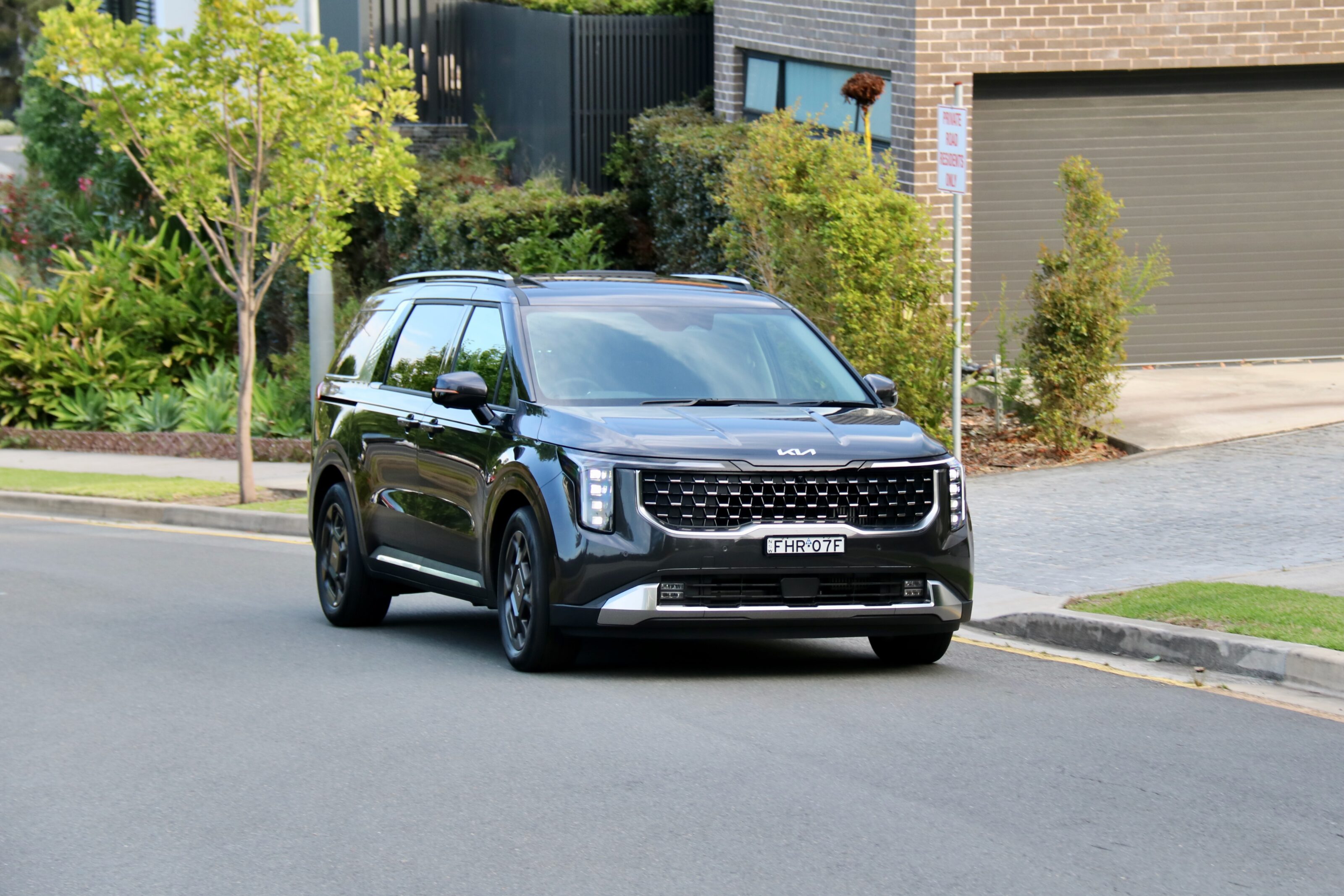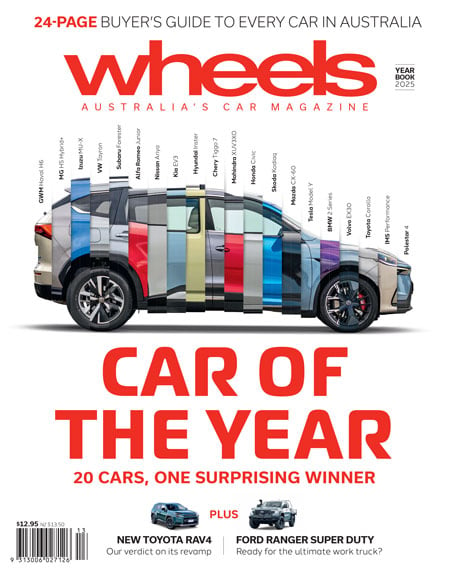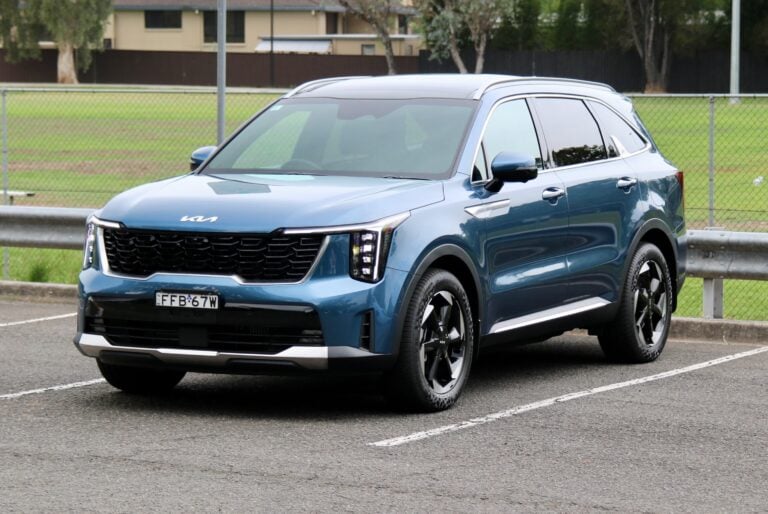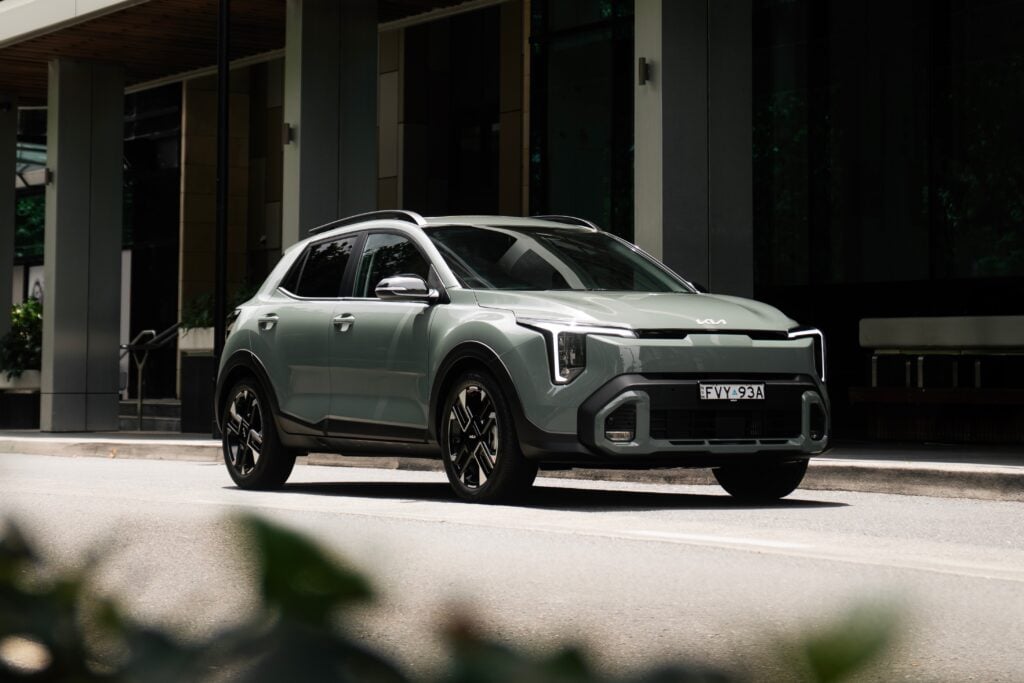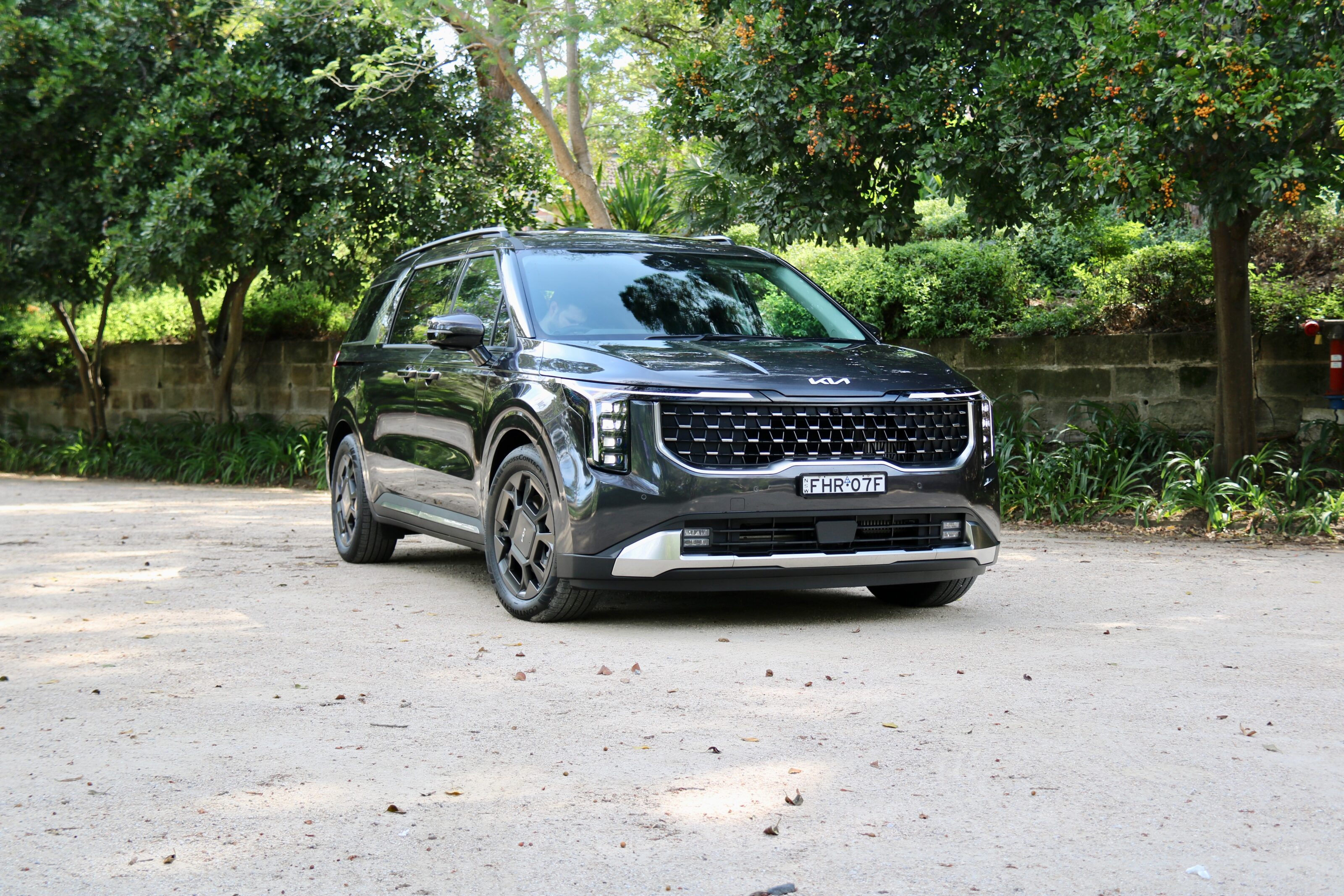
- Price: $76,630 plus on-road costs
- Engine: 1598cc 4-cyl turbo DOHC petrol, 132kW/265Nm
- Electric motor: front permanent magnet synchronous, 54kW/304Nm
- Battery: 1.49kWh
- Combined outputs: 180kW/366Nm
- Transmission: 6-speed automatic, FWD
- Fuel consumption (claimed/on test): 5.8L/100km / 6.7L/100km
- L/W/H/WB: 5155/1995/1785/3090mm
- Tare weight: 2288kg
- Boot: 627L (8-seat)/2827L (5-seat)
- 0-100km/h: 9 seconds (est)
| Rating |
|---|
Things we like
- Finally a reasonably priced hybrid people mover
- Humungous inside and insanely practical
- Good to drive, despite its size
Not so much
- Big price premium for the hybrid
- Middle row of seats can’t be easily removed
- No spare wheel for the hybrid

The Kia Carnival is the undisputed sales king of the people mover segment in Australia. Whereas the Toyota Tarago used to be the default in this class, the Carnival slowly ate up its sales and now remains one of the few available in our market, with over 10,000 vehicles sold in 2024.
Until last year, the Carnival was only available with either V6 petrol or four-cylinder diesel drivetrains but the brand added a new hybrid along with its mid-life facelift. Has the hybrid added appeal to the Kia Carnival and will it continue its sales dominance?
Price and equipment
The Kia Carnival is available in a number of versions in Australia and we tested the most expensive model available, though the company recently added new lower-spec hybrid variants for the base S and mid-spec Sport+ for those with more modest budgets.
2025 Kia Carnival pricing:
| Carnival S petrol | $50,570 |
| Carnival S diesel | $52,800 |
| Carnival S hybrid | $56,100 |
| Carnival Sport petrol | $56,470 |
| Carnival Sport diesel | $58,700 |
| Carnival Sport+ petrol | $62,800 |
| Carnival Sport+ diesel | $65,030 |
| Carnival Sport+ hybrid | $68,330 |
| Carnival GT-Line Lite petrol | $66,770 |
| Carnival GT-Line Lite diesel | $69,000 |
| Carnival GT-Line petrol | $71,100 |
| Carnival GT-Line diesel | $73,330 |
| Carnival GT-Line hybrid | $76,630 |
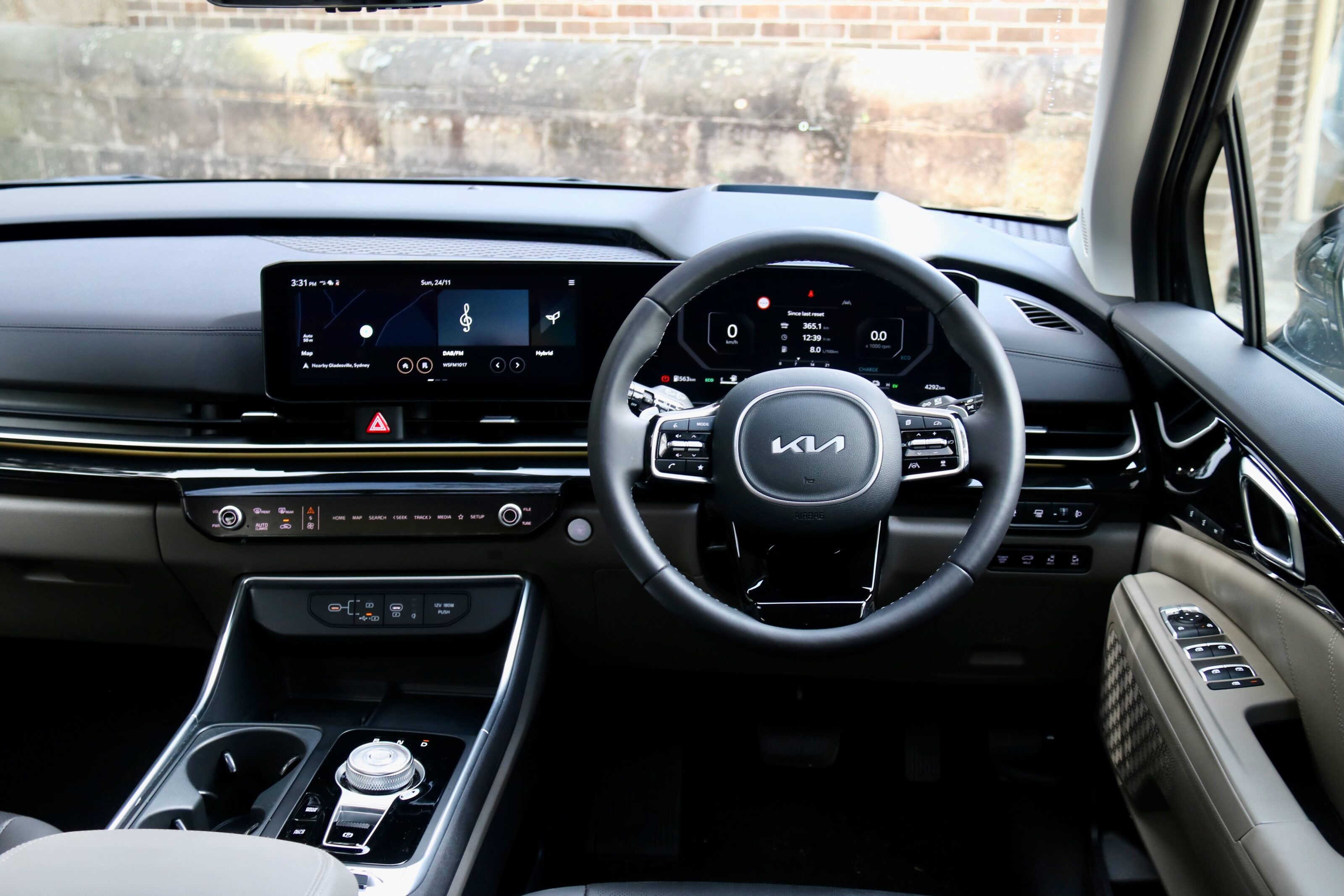
The Carnival GT-Line hybrid is equipped with:
- 19-inch alloy wheels
- Dusk-sensing automatic LED exterior lighting
- Rain-sensing automatic wipers
- Roof rails
- Rear privacy glass
- Keyless entry with push button start
- Remote start and remote smart park assist
- Heated and auto-folding mirrors
- Dual sunroofs
- Power side doors and tailgate
- 12.3-inch digital driver’s display
- 12.3-inch touchscreen with live services and over-the-air updates
- Wired/wireless Apple CarPlay and Android Auto
- Satelite navigation
- AM/FM/DAB+ digital radio
- 12-speaker Bose sound system
- Synthetic leather upholstery
- Heated, ventilated and electrically adjustable front seats with driver’s memory
- Heated outboard middle seats
- Tri-zone automatic climate control
- Heated synthetic leather steering wheel with paddle shifters
- 6x USB-C charging ports
- Head-up display
- Digital rear mirror
- Rear window sunshades
- Eco, sport and smart driving modes
- Interior ambient lighting

Performance and economy
Like its Sorento Hybrid sibling, the Kia Carnival Hybrid uses a turbocharged 1.6-litre four-cylinder petrol engine that’s combined with an electric motor, sending power only to the front wheels via a six-speed automatic transmission. The electric motor draws power from a 1.49kWh battery and total system outputs are 180kW of power and 366Nm of torque – more than the Sorento’s 169kW/350Nm outputs thanks to a beefed up electric motor.
Kia claims combined fuel consumption of 5.8L/100km with combined CO2 emissions of 132g/km, and we achieved 6.7L/100km in our week with it in mixed driving. Importantly, its 4.2L/100km urban claim is less than one third of the thirsty V6 (13.2L/100km) and you’d likely see an even bigger difference in the real world. The Carnival Hybrid features a big 72-litre fuel tank and runs on 91RON regular unleaded fuel.

Interior comfort, practicality and boot space
If you’re buying a people mover, chances are that you’re already well aware of just how practical they are and the Carnival is a great example of that. Sure, a Hyundai Staria is even more practical for storage but that’s an even larger vehicle – probably too large for many buyers. The Carnival’s front cabin is great for storage with a big open centre console, central box and door bins, while material quality is good as well with lots of soft touch plastics throughout.
The middle row of the Carnival is huge and three taller adults will be more than comfortable. Amenities include a separate zone of climate, USB-C ports in the back of the front seats, heated outboard seats, blinds in the door, bottle holders and – with the middle seat folded – a huge arm rest. The middle row slides and reclines easily, and getting into the third row is very easy.
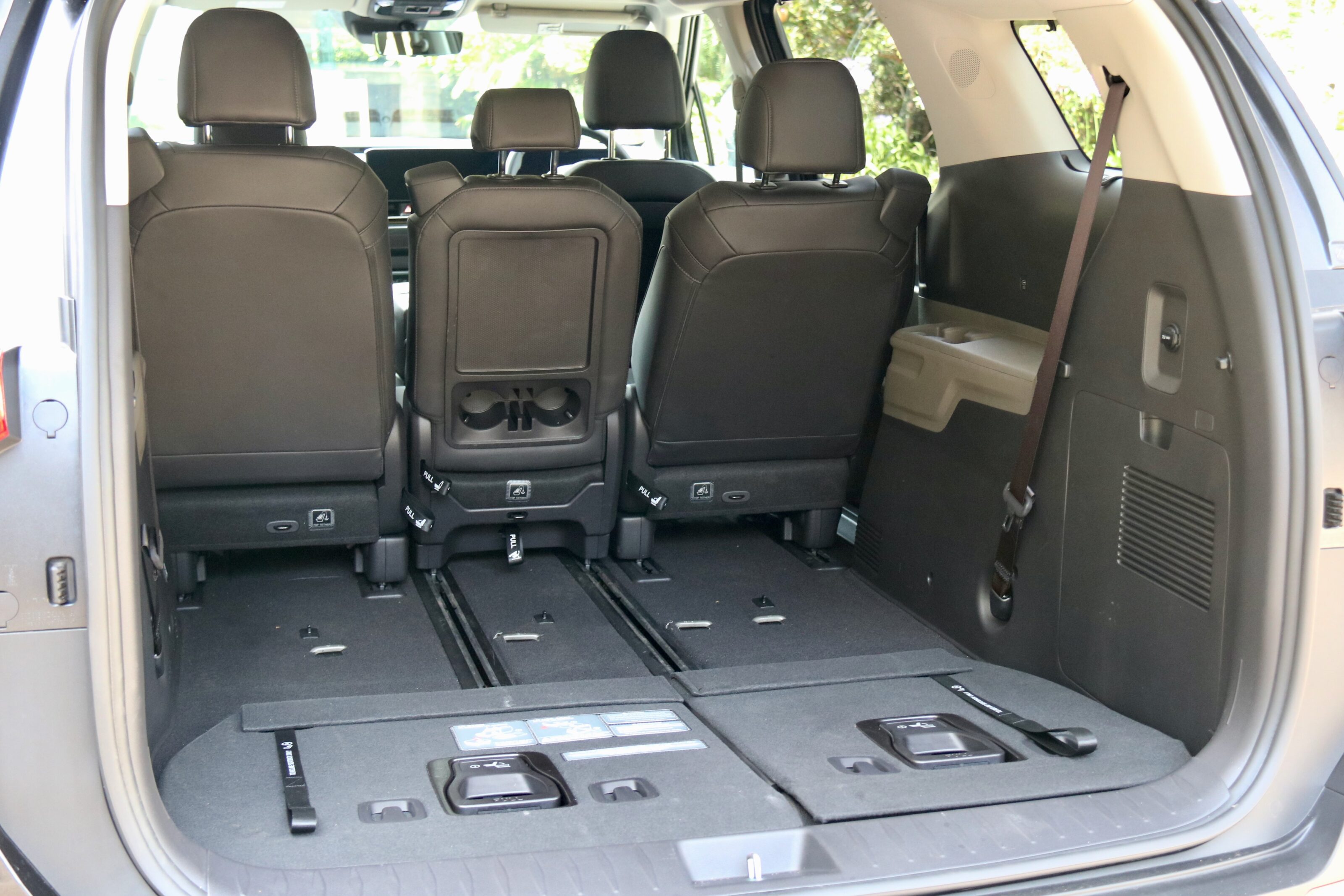
While the third row of a lot of SUVs is largely kids-only, the Carnival says no and welcomes even taller adults with open arms. It’s more spacious in there than the second row of a lot of mid-size SUVs and with a separate glass roof panel, air vents, USB-C ports and cup holders, there are more features too. Importantly for child seats, both the second and third rows of seating feature both ISOFIX and top-tether points.
Behind the third row of seats is a huge 627 litres of space and the third row of seats can be easily folded in to the floor to create a flat load bay. Doing so opens up a huge 2827L of space – or more than double that of something like a Mazda CX-5, yet still with five seats in use. Kia doesn’t quote a middle row folded figure, but it’s probably something over the 4000L mark. You just know that Kia had a picture of an Ikea showroom as inspiration for when this Carnival was designed.
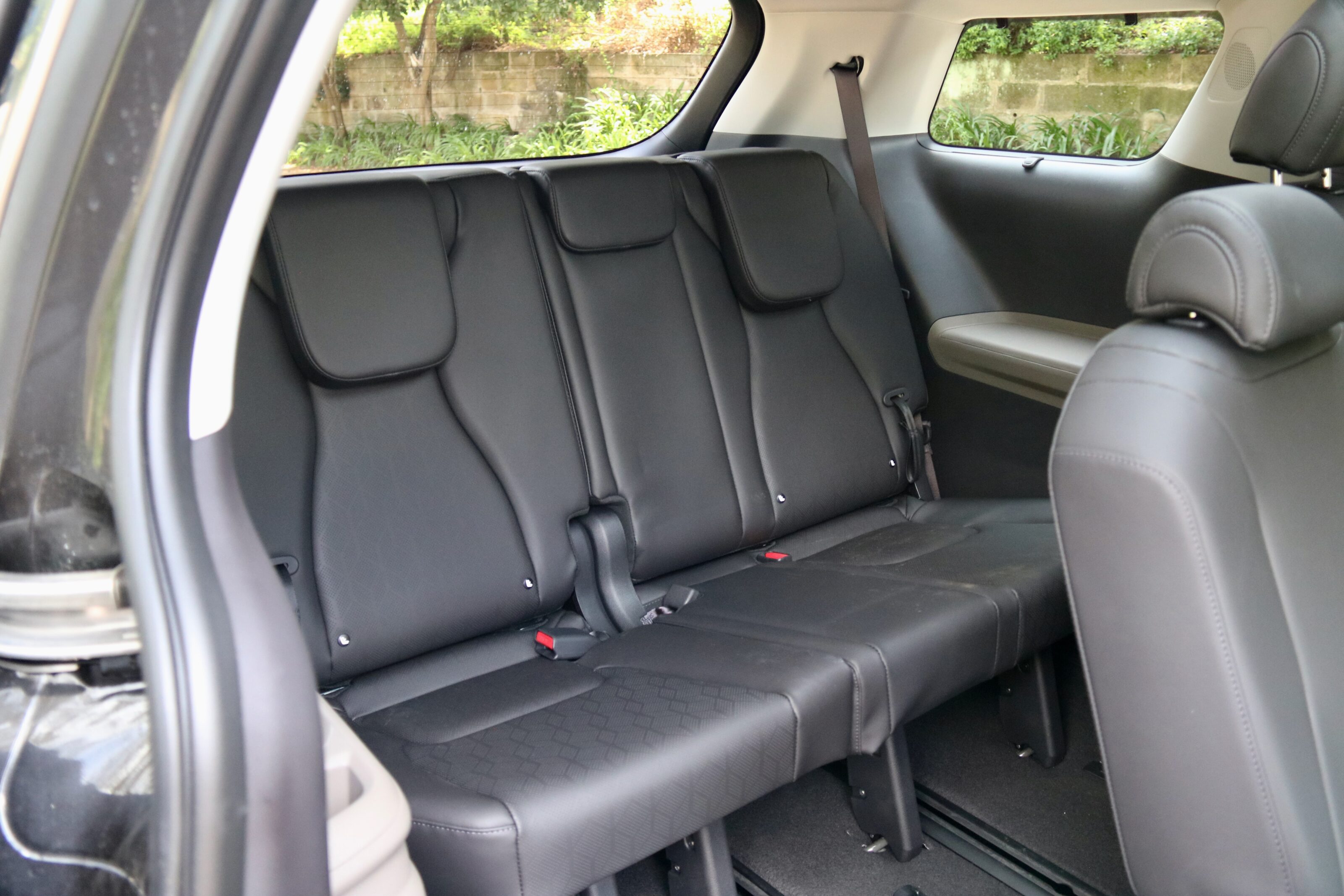
Back at the front, the new 12.3-inch touchscreen uses the brand’s new ‘ccNc’ software and it’s a breeze to use, while also being well featured with wireless and wired smartphone mirroring, satellite navigation and digital radio. The screen is a bit dark, but the screen quality is excellent and overall, there’s very little wrong with the Carnival’s cabin.
On the road
In its current generation, the Kia Carnival has always impressed on the road thanks to an excellent ride quality that was honed by Kia’s local engineers, and the new hybrid is no different. Weighing 93kg more than the diesel and 128kg more than the V6 petrol variants, the Carnival Hybrid’s extra weight can be felt a bit in corners but the reality is that no Carnival is a sports car, and with that in mind, it drives quite well.
The ride is soft and comfortable, the handling is reasonable and noise suppression is largely excellent. It also hides its size well, with light steering weighting at lower speeds and a very useful surround view camera system to help with parking.

The hybrid drivetrain is smooth and is an excellent urban companion. Whereas the diesel has turbo lag and the V6 doesn’t make its peak torque until 5500rpm, the hybrid electric motor’s 304Nm peak torque is available from 0rpm and it feels much quicker off the mark as a result.
At higher speeds, it doesn’t feel quite as fast as it’s the petrol engine doing most of the work, but it’s still got more than enough grunt and is still able to drive electrically at that speed for short bursts.
Service and warranty
Like other new Kia models, the Carnival GT-Line Hybrid is covered by a seven-year/unlimited km warranty with up to eight years of roadside assistance if serviced through a Kia dealership. A seven-year/150,000km warranty covers the hybrid battery.
The Carnival Hybrid’s annual service intervals are a short 10,000km, and five years/50,000km of servicing costs $2967 or $596 annually. For those considering the diesel Carnival, its five-year service cost is slightly better at $2851 ($570 annually) but its 15,000km intervals mean that it can travel 5000km further annually before needing a service.
Safety
Carnival GT-Line safety features:
- 8 airbags (including a front centre unit)
- Autonomous emergency braking (AEB) with pedestrian, cyclist, oncoming lane change and intersection detection
- Lane keeping assistance with adaptive lane guidance
- Adaptive cruise control with highway drive assist with lane change assist
- Intelligent speed limit assist
- Driver attention monitoring
- Safe exit warning with safe exit assist
- Auto high beam
- Blind-spot monitoring with a camera feed when indicating (with braking)
- Rear cross-traffic alert (with braking)
- 360-degree camera
- Front, side and rear parking sensors
- eCall SOS button in overhead console
- Rear low-speed automatic braking
The Carnival received a five-seat ANCAP safety rating in 2021, and the company has added more safety features since then, like an upgraded AEB system.

Verdict: Should I buy a 2025 Kia Carnival GT-Line Hybrid?
Firstly, if you’re considering a people mover: well done, they’re much more practical and efficient than an equivalent SUV like a Sorento that shares showroom space with the Carnival. Secondly, if you are considering one, chances are that the Carnival is high on your shortlist and deservedly so, because in our opinion, this is a product that does so much correctly and it’s no surprise to see why it’s so popular in Australia.
Is the hybrid variant worth it over the other Carnival drivetrains? That depends on your driving. If you do a lot of highway miles, we’d suggest the diesel as it costs less to buy and can travel further before needing a service. But against the thirsty and $5530-cheaper V6? We’d say that it’s a no-brainer as it’s significantly more fuel efficient in the real world and you would likely make the considerable cost difference back within five years. While it isn’t for every buyer, the new hybrid drivetrain adds more appeal to the Kia Carnival for likely even more market domination.
Kia Carnival rivals
